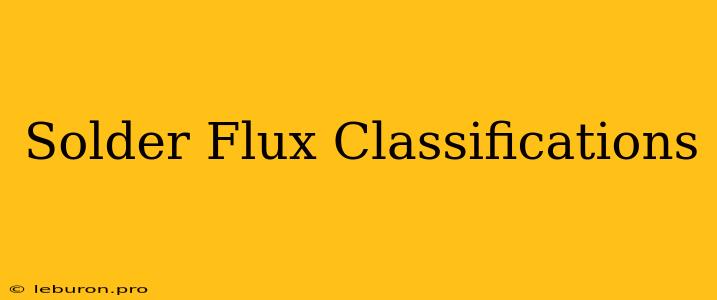Solder flux is an essential component in the soldering process, acting as a cleaning agent and promoting the wetting of surfaces by molten solder. It facilitates a strong and reliable electrical and mechanical connection by removing oxides and contaminants from the surfaces being joined. However, the effectiveness of solder flux hinges upon its classification, which dictates its properties and suitability for specific applications. This article delves into the various solder flux classifications, exploring their characteristics, applications, and considerations for selecting the right flux for your soldering needs.
Solder Flux Classifications: A Comprehensive Overview
The classification of solder flux is a crucial aspect of soldering, ensuring the selection of the appropriate flux for the specific application and minimizing potential risks. These classifications are based on several factors, including their chemical composition, activation temperature, and cleaning requirements.
1. Activity Level:
This classification describes the strength or aggressiveness of the flux, determining its ability to remove oxides and contaminants. The activity level is directly related to the flux's chemical composition and its corrosive potential. The widely recognized classifications are:
- **** Type R (Rosin-based): These fluxes are considered mild and utilize a natural resin, rosin, as their primary component. They exhibit relatively low activity and are suitable for general-purpose soldering applications where minimal cleaning is required after soldering. They are preferred for electronic applications, particularly those involving sensitive components that can be susceptible to damage by aggressive cleaning agents.
- **** Type RMA (Rosin-based, mildly activated): This type of flux is similar to Type R but contains added activators, making it slightly more aggressive. The activators, usually organic acids like rosin acid, enhance the flux's cleaning power while maintaining a relatively low corrosive potential. Type RMA fluxes are suitable for a wide range of applications, including electronic assemblies and general soldering tasks.
- **** Type OA (Organic Acid): These fluxes are moderately aggressive, utilizing organic acids like hydrochloric acid or phosphoric acid as activators. They offer improved cleaning capabilities compared to Type R and Type RMA fluxes, making them suitable for applications requiring stronger cleaning action. However, they require thorough post-soldering cleaning to prevent corrosion.
- **** Type WS (Water Soluble): These fluxes are specifically formulated to dissolve in water, facilitating easy post-soldering cleaning. They often contain organic acids and activators but are less corrosive than Type OA fluxes. Water-soluble fluxes are particularly suitable for applications where cleaning is a paramount concern, such as in delicate electronic circuits or sensitive medical devices.
- **** Type SA (Synthetic Activated): These fluxes are highly active and contain synthetic activators, typically halogenated compounds or inorganic acids. They offer excellent cleaning capabilities but are highly corrosive and necessitate stringent post-soldering cleaning to avoid corrosion. Type SA fluxes are typically reserved for specialized applications where aggressive cleaning is required, such as soldering stainless steel or other difficult-to-solder materials.
2. Activation Temperature:
This classification relates to the temperature at which the flux becomes activated and starts to perform its cleaning action. The activation temperature is crucial in determining the suitability of a flux for specific soldering processes.
- **** No-Clean Fluxes: These fluxes activate at a lower temperature than traditional fluxes and are designed to leave a minimal residue after soldering. They are typically used in applications where post-soldering cleaning is impractical or undesirable, such as in high-volume production lines or for delicate components.
- **** Cleanable Fluxes: These fluxes activate at a higher temperature and require post-soldering cleaning to remove the flux residue. They are more common in applications where thorough cleaning is necessary to prevent corrosion or contamination.
3. Cleaning Requirements:
The cleaning requirements of a flux depend on its activity level and activation temperature. Certain fluxes, like Type R and Type RMA fluxes, can be cleaned with simple solvents, while others, such as Type OA and Type SA fluxes, necessitate more robust cleaning techniques.
- **** Solvent Cleaning: Solvents like isopropyl alcohol or flux remover can be used to clean mild fluxes like Type R and Type RMA.
- **** Water Cleaning: Water-soluble fluxes like Type WS can be easily cleaned with water.
- **** Ultrasonic Cleaning: Aggressive fluxes like Type OA and Type SA may require ultrasonic cleaning to effectively remove the flux residue.
4. Soldering Process:
The soldering process itself can also influence the selection of the appropriate flux. For example, wave soldering, which involves submerging a circuit board in a wave of molten solder, requires a flux that can withstand the high temperatures and pressures involved.
Considerations When Choosing a Solder Flux:
- **** Solderability of the Materials: The materials being soldered will determine the type of flux required. For instance, soldering stainless steel will require a more aggressive flux than soldering copper.
- **** Environmental Sensitivity: Electronic components and circuits can be sensitive to the corrosive effects of some fluxes. It is important to select a flux that minimizes the risk of corrosion and meets the specific environmental requirements of the application.
- **** Cleaning Availability: The availability of cleaning facilities and the complexity of the cleaning process are crucial considerations when selecting a flux.
- **** Cost: The cost of the flux, its cleaning requirements, and any associated cleaning expenses should be factored into the decision-making process.
Conclusion:
Solder flux classifications play a vital role in ensuring the success and reliability of the soldering process. Understanding the different solder flux classifications is essential for selecting the right flux for the application, minimizing corrosion and contamination risks, and maximizing the performance and longevity of the soldered connection. By carefully considering the activity level, activation temperature, cleaning requirements, and the specific soldering process, engineers and technicians can ensure the appropriate flux is chosen, leading to robust and reliable soldered joints.
